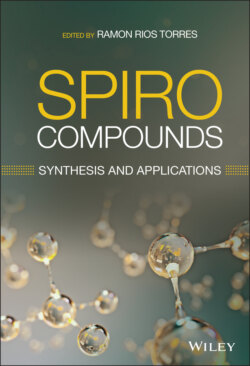Читать книгу Spiro Compounds - Группа авторов - Страница 2
Table of Contents
Оглавление1 Cover
5 Preface
6 1 Spiro Compounds: A Brief History 1.1 Notes on IUPAC Rules for Spiro Compounds References
7 2 Selected Applications of Spirocycles in Medicinal Chemistry 2.1 Introduction 2.2 General Features 2.3 Property Optimization in Bioactive Compounds 2.4 Four‐Membered Rings: Synthesis, Applications, and New Design Principles 2.5 Further Examples 2.6 Conclusions References
8 3 Recent Advances in the Asymmetric Synthesis of Spiro Compounds Through Cycloadditions 3.1 Introduction 3.2 Organometallic Methodologies 3.3 Organocatalytic Methodologies References
9 4 Design and Synthesis of Spirocycles via Olefin Metathesis 4.1 Introduction 4.2 Formation of Aza‐spirocycles 4.3 Formation of Oxa‐spirocycles 4.4 Miscellaneous Examples References
10 5 Spirooxindoles: Synthesis via Organocatalytic Processes 5.1 Introduction 5.2 Enamine and Iminium Catalysis 5.3 Chiral Nucleophilic Catalysis with Tertiary Phosphines or Amines 5.4 Chiral N‐Heterocyclic Carbene Catalysis 5.5 Chiral Tertiary Amine‐H‐Bond Donor Bifunctional Catalysis 5.6 Chiral Hydrogen‐Bonding Catalysis 5.7 Chiral Phosphoric Acid Catalysis 5.8 Chiral Phase‐Transfer Catalysis 5.9 Chiral Organoiodine Catalysis 5.10 Conclusion References
11 6 Spirooxindole Synthesis by Organometallic Processes 6.1 Introduction 6.2 Direct Construction of the Spirooxindole Unit by Cyclization Methodologies 6.3 Two‐component Annulation/Cycloaddition Methodologies 6.4 Miscellaneous Methods 6.5 Conclusions Acknowledgements References
12 7 Enantioselective Synthesis of Spiro Heterocycles 7.1 Introduction 7.2 Enantioselective Synthesis of Spiro Heterocycle with One Nitrogen Atom 7.3 Enantioselective Formation of Spirocycles Containing Heterocycle with One Oxygen Atom 7.4 Enantioselective Formation of Sulfur‐containing Spirocycles 7.5 Enantioselective Formation of Spirocycles Containing Heterocycle with More Than One Heteroatom 7.6 Enantioselective Formation of Other Spiro Heterocyclic Systems 7.7 Enantioselective Formation of Bispirocycles 7.8 Conclusion Acknowledgements References
13 8 Enantioselective Synthesis of all Carbon Spiro Compounds 8.1 Enantioselective Synthesis of All‐Carbon Spiro Compounds Based on Alkylation Methods 8.2 Enantioselective Synthesis of All‐Carbon Spirocycles by Metal‐catalyzed Methods 8.3 Enantioselective Synthesis of All‐Carbon Spirocycles by Cycloaddition Strategies 8.4 Enantioselective Synthesis of All‐Carbon Spirocycles by Radical Strategies 8.5 Enantioselective Synthesis of All‐Carbon Spirocycles by Cascade Reactions 8.6 Enantioselective Synthesis of All‐Carbon Spirocycles by Rearrangement Strategies 8.7 Conclusions References
14 9 Transition‐Metal‐Catalyzed Dearomative Spiroannulation Reactions 9.1 Introduction: Discovery of Aromatic Compounds 9.2 Development of Dearomatization Reactions 9.3 Development of Dearomative Spiroannulation Reactions 9.4 Dearomative Spiroannulations of Phenols 9.5 Dearomative Spiroannulation of Indoles 9.6 Dearomative Spiroannulation of Aromatic Heterocyclic Compounds 9.7 Dearomative of Other Aromatic Compounds 9.8 Conclusion References
15 10 Carbocyclic Spiro Compounds Occupying Higher Dimensions: Benzoannelated [5.5.5.5]Fenestranes and Beyond 10.1 Introduction 10.2 Selected Synthesis Strategies 10.3 Conclusions Acknowledgements References
16 11 The Synthesis of Natural Products Containing Spirocycles 11.1 Porco’s Synthesis of (+)‐Calafianin [2] 11.2 Hayashi’s Total Synthesis of Pseurotin A[6] 11.3 Trost’s Synthesis of (−)‐Ushikulide A [12] 11.4 Castle’s and Herzon’s Syntheses of (−)Acutumine 11.5 Overman’s and Carreira’s Synthesis of Spirotryprostatin B 11.6 Conclusion References
17 Index
